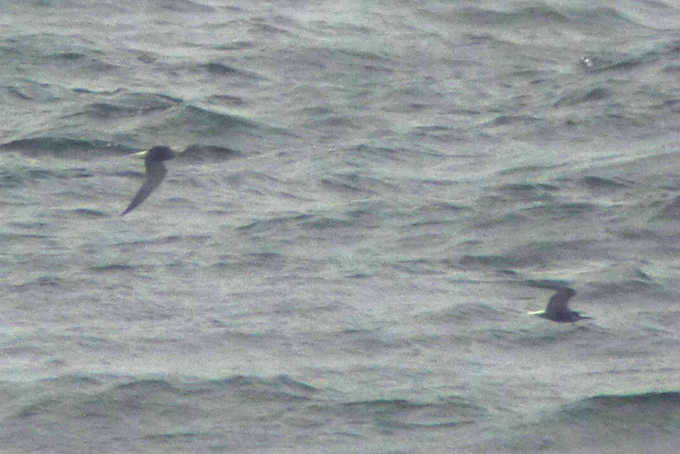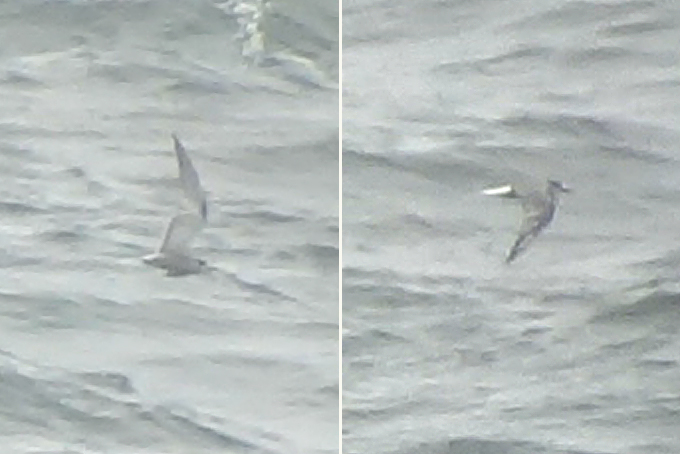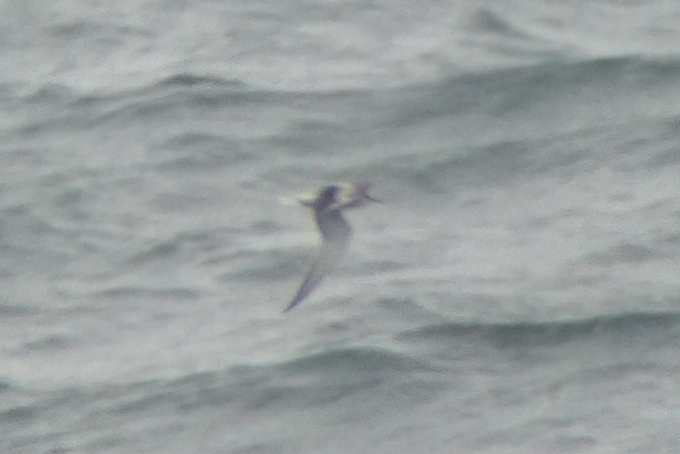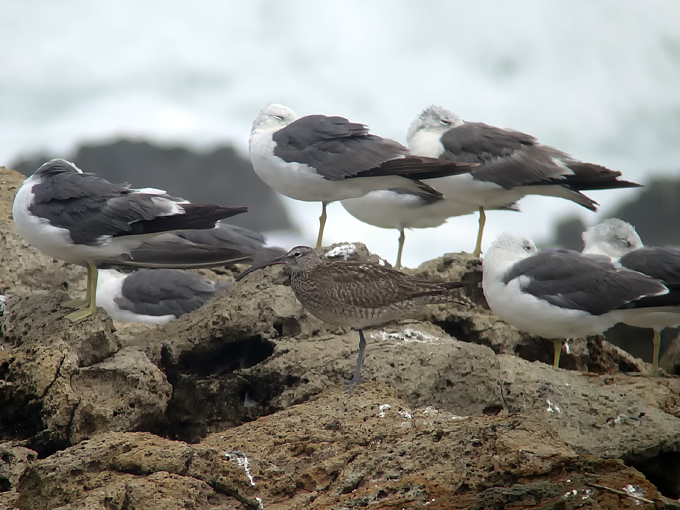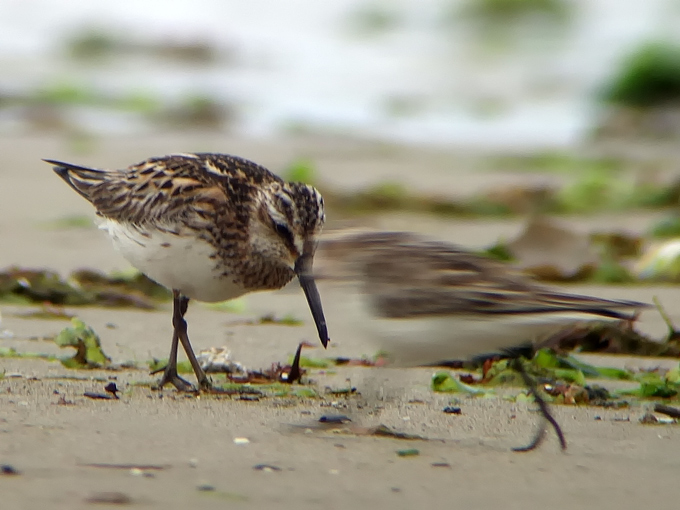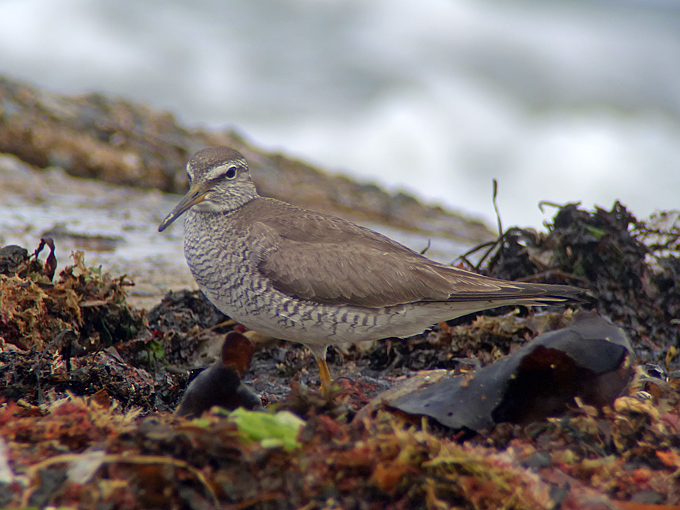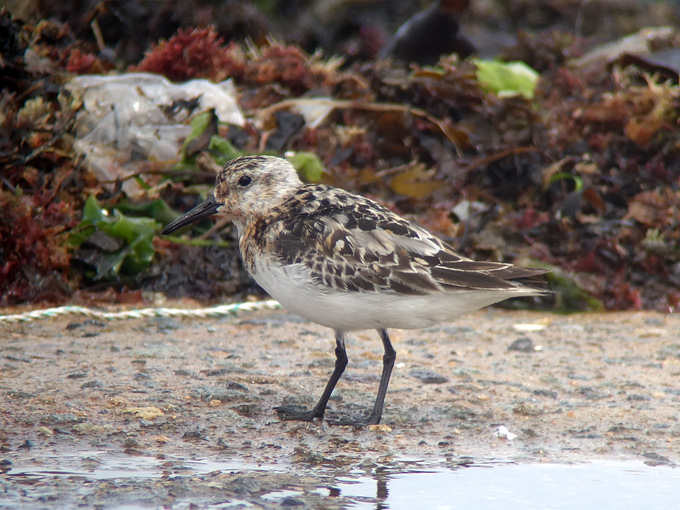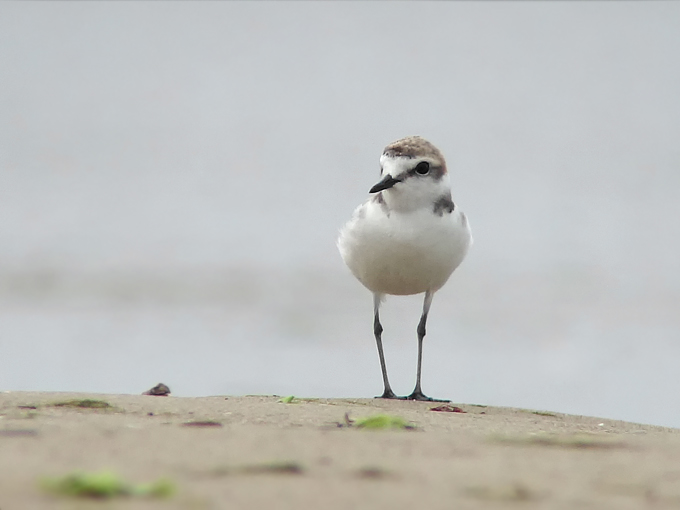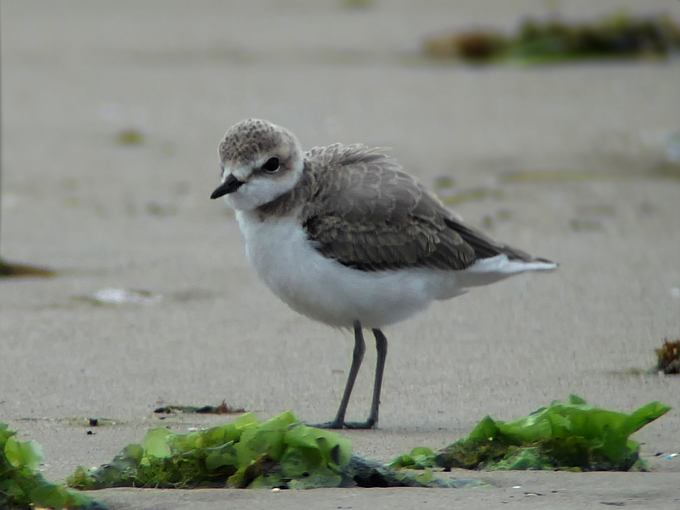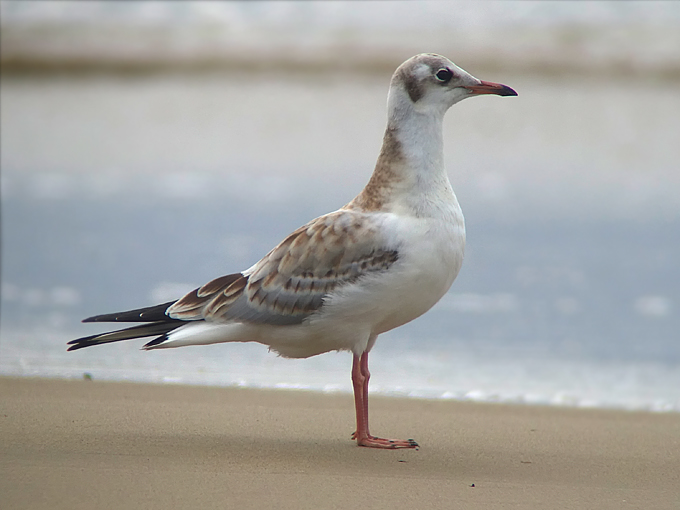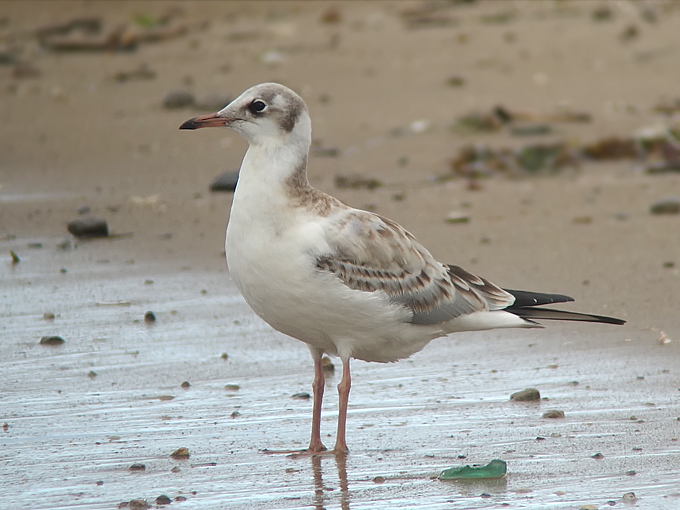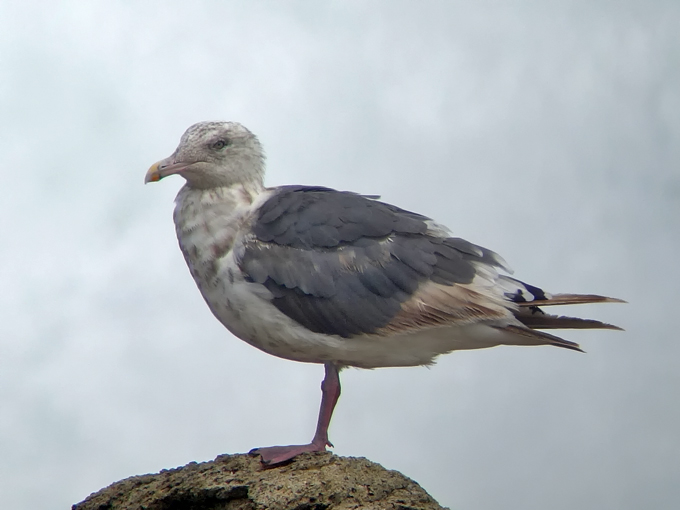Bird News from Nial Moores with Jason Loghry
Even though Typhoon Halong was centred off southern Japan, its influence was apparent in the southeast of the ROK. In strong northeasterlies during the late afternoon of the 9th, NM counted large numbers of birds (mostly Streaked Shearwater and Red-necked Phalarope and other shorebirds, containing one or two orange-bellied birds, perhaps Red Phalarope?) moving off Busan. With the wind forecast to switch to the north, NM and JL headed for the Guryongpo Peninsula on the 10th seawatching from about 0730-1330, and then searching for grounded migrants on the headland and the main southwestern beach until 1800.
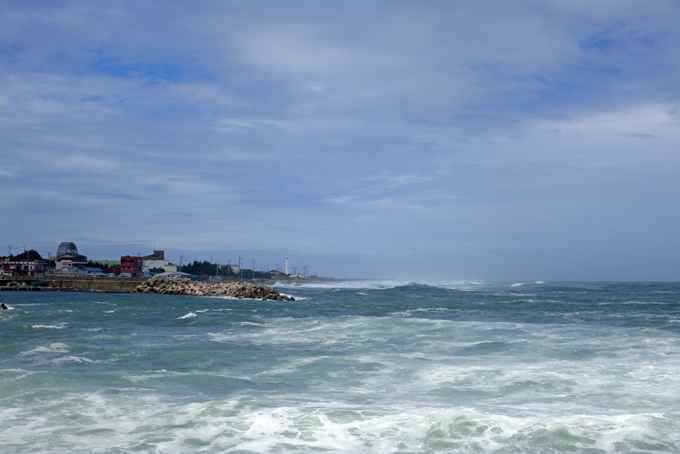
Through the morning of the 10th, in heavy overcast with visibility ranging from 500m to 10km, moderate to strong northerlies and a large sea-swell, we found low thousands of birds trying to move around the Guryongpo Peninsula headland, with each pulse of rain and falling visibility producing waves of birds closer to shore. There were multiple exceptional highlights, but very few images because of the extremely poor conditions. Along with high numbers of Common Tern and Red-necked Phalarope, the morning’s highlights included a Sooty Shearwater (only one previous sight record nationally), a Bulwer’s Petrel (only 1 or 2 previous national records), probably six Aleutian Tern and two or three probable / presumed Arctic Tern (first national claim?). In the afternoon, as the weather brightened and the winds dropped, time was spent looking for migrant shorebirds (finding c.15 Whimbrel, 2+ Far Eastern Curlew, single Common Redshank, Terek and Broad-billed Sandpipers, 7+ Ruddy Turnstone, 10+ Grey-tailed Tattler, 30+ Sanderling, 10 Red-necked Stint, two Dunlin, 3+ Kentish and two Grey Plovers), distant terns and gulls (including 100s of Black-tailed Gull, 25+ Black-headed Gull, including several fresh juveniles, 9+ Slaty-backed Gull and one adult Vega Gull).
Details of selected highlights are as follows:
- Baikal Teal Anas formosa? A small dark duck disappearing into the murk showed a strong pale trail to the speculum, but only a weak leading edge. It therefore appeared a best match for Baikal Teal – which usually do not start to arrive in Korea until September.
- Streaked Shearwater Calonectris leucomelas. In three hours on the 9th, close to 2,000 passed Igidae heading into the wind, with 100 birds passing north every 5-6 minutes after 17:30. On the Guryongpo Peninsula on the 10th, 65 passed close to shore in the first (quiet) 30 minutes; and later c. 300 were visible in one scan once visibility had improved. No other counts were made, and as birds were almost always in view, passing by every minute or so, and larger flocks were visible feeding in brighter spells, probably 1,500- 2,000 were seen during the day.
- Sooty Shearwater Puffinus griseus. Only one dark shearwater was seen (at 11:35), found by NM and ‘scoped by both of us for probably 20 seconds or so at medium-range. Strikingly, it was powerfully-built, simultaneously more muscular and graceful looking than the larger Streaked Shearwaters it was with, overtaking them easefully with several deep rapid flaps followed by an extended banking glide followed by more deep flaps. On the first view, as the bird banked to show its underwing in half-decent light, NM noted a clear, contrasting white stripe on the underwings, most striking on what appeared to be the primary coverts. The bird looked dark-billed at all times (including when in the same ‘scope view as a Streaked, in which paleness of the bill and other plumage details were strongly evident in the latter species), and the head and bill looked strong, with a sloping forehead (lacking the steep-forehead shown by many Short-tailed Shearwater). In very dull light, the bird appeared plainly dark blackish brown, clearly lacking a hooded look or the paler chin as often shown by (immature) Short-tailed, but with a marginally paler belly (either reflected light from the sea or a genuine paling). Although dark shearwaters are notoriously difficult to ID, the combination of flight action (which for NM immediately recalled Sooty Shearwater); the all-dark bill; and the other plumage details in combination seem sufficient to ID this as a Sooty. The only previous claim known to Birds Korea is of two seen (also by NM) from a ferry just offshore from Busan on June 6th 2002. As this is the second sighting, the species will probably be moved from Category 4 to Category 3 of the Birds Korea Checklist during the next formal update.
- Bulwer’s Petrel Bulweria bulwerii. At 12:40, one was seen flying within 100m-200m of shore first by JL (rendering him temporarily speechless!), and then ‘scoped for probably 5 seconds at most by NM. Identification was based on a composite of impressions: all blackish-brown, with a slightly darker-looking head; small and slender-bodied, with a long tail that appeared tapering, even slightly lozenge like; exceptionally long-winged; with wings held angled back one moment like a miniature falcon, the next outstretched like a shearwater; with a flight action that seemed intermediate between a Swinhoe’s Storm Petrel and a shearwater, one moment flying rapidly in one direction, the next shearing and accelerating away in a different direction low over the waves. No images were taken. There is one previous record nationally (one found wrecked on Jeju on August 12th 2010). The shape and some of the flight action of the Guryongpo individual was strongly reminiscent of a large unidentified petrel seen by NM at Igidae after the passage of Typhoon Sanba on September 18th 2012.
- Red-necked Phalarope Phalaropus lobatus. 690 were counted moving round the headland between 12:00 and 12:30, with smaller numbers passing by at other times (but none were found once seas were calmer)
- Common Tern Sterna hirundo. Probably 1,000-1,500 were seen during the day. Most appeared to be adults in full breeding plumage, though some were moving into non-breeding plumage and many of those seen feeding (c.50 in total) were in juvenile plumage. In the first quiet 30 minutes, 112 were counted passing the count point; 85 were counted between 0830 and 0855; 148 were counted between 10:40 and 10:49; and a single group of 120 was watched heading south then spiraling up over the bay in the evening.
- Arctic Tern Sterna paradisaea. As there are no records for Korea, the three Arctic-Tern lookalikes seen on the 10th (none of which were photographed) need to be left as probables. Two were in full breeding plumage (one passing the count point at 10:20 when it was well-scoped by NM for perhaps 15-20 seconds; the second, or much less likely the same one, was near the beach in the late afternoon, seen distantly though in good light). The adults shared medium grey upperparts (in the first, in very dull conditions the upperparts appeared perhaps one shade darker than most of the Commons?) and greyish underparts, with a perhaps cleaner white stripe below the black of the cap and the grey of the underparts than shown by Common; clear black trail to the primaries, which were otherwise pearly grey-white (much cleaner and paler looking than Commons in direct comparison); strongly contrasting white rump and in the first adult, “exaggerated-looking” tail streamers. The juvenile, seen passing the count point also in very poor light, looked paler-winged than the juvenile Commons, with dark restricted to the leading edge, with grey primaries and white secondaries lacking any obvious darker trail. We were unable to take any images.
- Aleutian Tern Onychoprion aleuticus. At least six were seen well enough to identify (and at least four were very poorly digiscoped), one by itself at 0850; two together at 10:10; and three (or four) together at 11:55. All seemed to be moving from breeding plumage to non-breeding plumage. All were identified on obviously darker upperparts than the Commons, with strikingly contrasting white rump and fairly short tail streamers; white foreheads, with either solid black cap and loral line, or more broken loral line; dark outer primaries and paler inner primaries; and on several birds, clean black trail to the underside of the secondaries with faintly darker line on the upper side of the secondaries too. Aleutian Tern is probably regular in late August in Korean waters, and perhaps all (or at least almost all) of the obviously darker “common tern types” might well prove to be this species. This constitutes perhaps the earliest claim in Korean waters (by a week or more?); the largest day-count; and the first time that sight records have been supported by images (even if extremely poor, probably all the features can just be made out). As such Aleutian Tern will be moved to Category One of the Birds Korea Checklist during the next formal update.
- Whiskered Tern Chlidonias hybrida. At least one was seen at the count point during the morning.
- White-winged Tern Chlidonias leucopterus. At least two were seen near the beach: an adult moving into non-breeding plumage and a juvenile.
- Parasitic Jaeger Stercorarius parasiticus. Two: one (an all-pale brown juvenile or immature) seen reasonably well at 0920; the second an adult type (pale), most likely this species, more distantly, chasing terns at 0950.
- Ancient Murrelet Synthliboramphus antiquus. Two birds in non-breeding plumage swimming off the count point at 12:50.
